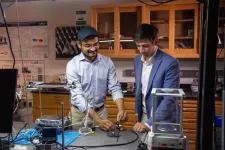(Press-News.org) Using a wearable device, such as a smart watch, to track health data and symptoms, is supposed to help people monitor their health and address symptoms as quickly as possible to spur positive health outcomes. But for people with atrial fibrillation, also known as Afib, using a wearable device to monitor the heart rate and to alert wearers of an irregular heartbeat might not be as helpful as wearers think.
A new study in the Journal of the American Heart Association, led by Lindsay Rosman, PhD, assistant professor of medicine in the division of cardiology at the University of North Carolina School of Medicine, is the first to show that wearable devices, such as smart watches, can significantly amplify anxiety and increase healthcare use in patients with Afib.
The study included 172 patients from UNC Health with a prior diagnosis of Afib who completed a survey and had their information linked to electronic health records. About half of the study sample had a wearable device and their data was compared to individuals without a wearable device. Rosman and her team found that patients with Afib who use wearables are more likely to be preoccupied with their heart symptoms, report concerns about their AFib treatment, and use healthcare resources compared to Afib patients without these devices. Providers and healthcare clinics were also impacted, as wearable users were more likely to call the clinic and send messages to their healthcare providers than individuals who did not have a device.
Also, 1 in 5 AFib patients who used wearables in this study experienced intense fear and anxiety in response to irregular rhythm notifications from their device. And a similar proportion (20%) routinely contacted their doctors when ECG results were abnormal or indicative of possible AFib. But it’s unclear if they actually needed to see a doctor, due to the alerts from their devices. It’s also unclear if the reported anxiety contributed to the worsening of symptoms, although anxiety has been a well-documented contributing factor to various conditions, including AFib.
“Given the significant increase in use of wearable devices in this patient group (and the population in general),” said Rosman, “we believe prospective studies and randomized trials are needed to understand the net effects of wearables – including their alerts – on patients’ healthcare use and psychological well‐being, as well as the downstream effects on providers, hospitals, and health systems.”
END
Wearable devices can increase health anxiety. Could they adversely affect health?
For patients with Afib, using a wearable device can lead to higher rates of anxiety about their Afib symptoms and treatment, doctor visits, and use of informal healthcare resources, according to a new study from UNC School of Medicine researchers.
2024-07-24
ELSE PRESS RELEASES FROM THIS DATE:
Addressing wounds of war
2024-07-24
Dr. Olga Denysiuk, MD, PhD, is a highly skilled eye surgeon in Ukraine who now finds herself at the frontlines of ophthalmic trauma care caused by war.
“Every day, I am fighting my war in the operating room,” says Denysiuk. “Cases of eye trauma are mounting and it’s critical that we have surgeons trained to delicately manage eyelid and orbital injuries.”
Denysiuk is one of two ocular specialists selected for a unique humanitarian fellowship at the University of Calgary’s ...
Rice researchers develop innovative battery recycling method
2024-07-24
A research team at Rice University led by James Tour, the T.T. and W.F. Chao Professor of Chemistry and professor of materials science and nanoengineering, is tackling the environmental issue of efficiently recycling lithium ion batteries amid their increasing use.
The team has pioneered a new method to extract purified active materials from battery waste as detailed in the journal Nature Communications on July 24. Their findings have the potential to facilitate the effective separation and recycling of valuable battery materials ...
It’s got praying mantis eyes
2024-07-24
Self-driving cars occasionally crash because their visual systems can’t always process static or slow-moving objects in 3D space. In that regard, they’re like the monocular vision of many insects, whose compound eyes provide great motion-tracking and a wide field of view but poor depth perception.
Except for the praying mantis.
A praying mantis’ field of view also overlaps between its left and right eyes, creating binocular vision with depth perception in 3D space.
Combining this insight with some nifty optoelectrical engineering and innovative “edge” ...
Stroke recovery: It’s in the genes
2024-07-24
New research led by UCLA Health has found that specific genes may be related to the trajectory of recovery for stroke survivors, providing doctors insights useful for developing targeted therapies.
Published in the journal Stroke this month, the findings were part of an exploratory study that sought to find if candidate genes could predict a higher likelihood of stroke outcomes related to depression, post-traumatic stress disorder and cognitive decline.
Dr. Steven C. Cramer, MD, the study’s lead author and a professor of neurology at UCLA, said while there are some ...
Foam fluidics showcase Rice lab’s creative approach to circuit design
2024-07-24
HOUSTON – (July 24, 2024) – When picturing next-generation wearables and robotics, the foam filling in your couch cushions is likely not the first thing that comes to mind.
However, Rice University engineers have shown that something as simple as the flow of air through the airy, meshlike structure of open-cell foam can be used to perform digital computation, analog sensing and combined digital-analog control in soft textile-based wearable systems.
“In this work, we integrated material intelligence — the ability of materials to sense and respond to their environment ...
Montana State scientists publish evidence for new groups of methane-producing organisms
2024-07-24
A team of scientists from Montana State University has provided the first experimental evidence that two new groups of microbes thriving in thermal features in Yellowstone National Park produce methane – a discovery that could one day contribute to the development of methods to mitigate climate change and provide insight into potential life elsewhere in our solar system.
The journal Nature this week published the findings from the laboratory of Roland Hatzenpichler, associate professor in MSU’s Department of Chemistry and Biochemistry in the College ...
Daily rhythms depend on receptor density in biological clock
2024-07-24
In humans and other animals, signals from a central circadian clock in the brain generate the seasonal and daily rhythms of life. They help the body to prepare for expected changes in the environment and also optimize when to sleep, eat and do other daily activities.
Scientists at Washington University in St. Louis are working out the particulars of how our internal biological clocks keep time. Their new research, published July 24 in the Proceedings of the National Academy of Sciences, helps answer longstanding questions about how circadian rhythms are generated and maintained.
In all mammals, the signals for circadian rhythms come from a small part of the brain called the suprachiasmatic ...
New England Journal of Medicine publishes outcomes from practice-changing E1910 trial for patients with BCR::ABL1-negative B-cell precursor acute lymphoblastic leukemia
2024-07-24
A significant survival improvement for adults with newly diagnosed BCR::ABL1-negative B-cell precursor acute lymphoblastic leukemia is published today by the New England Journal of Medicine. The practice-changing finding is from the randomized phase 3 study E1910 (NCT02003222), which evaluated blinatumomab immunotherapy in patients who were in remission and tested negative for measurable residual disease (MRD) after an initial round of chemotherapy. At 3 years of follow-up, 85% of the patients who went on to receive additional standard consolidation chemotherapy plus experimental blinatumomab were alive, compared to 68% of those who received chemotherapy only.
Blinatumomab (Blincyto, ...
Older adults want to cut back on medication, but study shows need for caution
2024-07-24
More than 82% of Americans age 50 to 80 take one or more kinds of prescription medication, and 80% of them say they’d be open to stopping one or more of those drugs if their health care provider gave the green light, a new University of Michigan study shows.
But it’s not as simple as that, the researchers say. They call for prescribers and pharmacists to talk with older adults about their personal situation and figure out if any kind of “deprescribing” is right for them.
The study, published in the Journal of General Internal Medicine, uses data from U-M’s National Poll on Healthy Aging, and builds on a poll report issued in April 2023.
It ...
Nationwide flood models poorly capture risks to households and properties
2024-07-24
Irvine, Calif., July 24, 2024 – Government agencies, insurance companies and disaster planners rely on national flood risk models from the private sector that aren’t reliable at smaller levels such as neighborhoods and individual properties, according to researchers at the University of California, Irvine.
In a paper published recently in the American Geophysical Union journal Earth’s Future, experts in UC Irvine’s Department of Civil and Environmental Engineering caution that relatively new, nation-scale flood data provides an inadequate representation of local topography and infrastructure, factors known to control the spread of floods ...
LAST 30 PRESS RELEASES:
Jeonbuk National University study shows positive parenting can protect adolescents against self-harm
Surface-engineered ZnO nanocrystals to tackle perfluoroalkyl substance contamination
This new understanding of T cell receptors may improve cancer immunotherapies
A new fossil face sheds light on early migrations of ancient human ancestor
A new immunotherapy approach could work for many types of cancer
A new way to diagnose deadly lung infections and save lives
40 percent of MRI signals do not correspond to actual brain activity
How brain-inspired algorithms could drive down AI energy costs
Gum disease may be linked to plaque buildup in arteries, higher risk of major CVD events
Contrails are a major driver of aviation’s climate impact
Structure of dopamine-releasing neurons relates to the type of circuits they form for smell-processing
Reducing social isolation protects the brain in later life
Keeping the heart healthy increases longevity even after cancer
Young adults commonly mix cannabis with nicotine and tobacco
Comprehensive review illuminates tau protein's dual nature in brain health, disease, and emerging psychiatric connections
Book prepares K-12 leaders for the next public health crisis
Storms in the Southern Ocean mitigates global warming
Seals on the move: Research reveals key data for offshore development and international ecology
Sports injuries sustained during your period might be more severe
World's first successful 2 Tbit/s free-space optical communication using small optical terminals mountable on satellites and HAPS
Can intimate relationships affect your heart? New study says ‘yes’
Scalable and healable gradient textiles for multi‑scenario radiative cooling via bicomponent blow spinning
Research shows informed traders never let a good climate crisis go to waste
Intelligent XGBoost framework enhances asphalt pavement skid resistance assessment
Dual-function biomaterials for postoperative osteosarcoma: Tumor suppression and bone regeneration
New framework reveals where transport emissions concentrate in Singapore
NTP-enhanced lattice oxygen activation in Ce-Co catalysts for low-temperature soot combustion
Synergistic interface engineering in Cu-Zn-Ce catalysts for efficient CO2 hydrogenation to methanol
COVID-19 leaves a lasting mark on the human brain
Scientists use ultrasound to soften and treat cancer tumors without damaging healthy tissue
[Press-News.org] Wearable devices can increase health anxiety. Could they adversely affect health?For patients with Afib, using a wearable device can lead to higher rates of anxiety about their Afib symptoms and treatment, doctor visits, and use of informal healthcare resources, according to a new study from UNC School of Medicine researchers.





